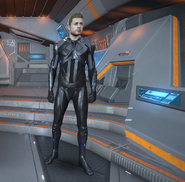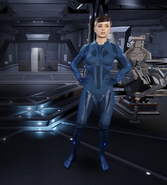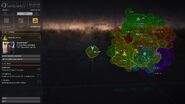(Working on page) Tags: Visual edit apiedit |
m (Made references more consistent) Tag: Visual edit |
||
| (60 intermediate revisions by 11 users not shown) | |||
| Line 1: | Line 1: | ||
| − | [[File:Human-Race-Male.png|thumb| |
+ | [[File:Human-Race-Male.png|thumb|250px|Human Male]] |
| + | '''Humans''' are a sentient [[species]] of bipedal mammals, native to planet [[Earth]] in the [[Sol]] system. Since the discovery of faster-than-light [[hyperspace]] travel, humans have rapidly expanded beyond Sol. They primarily populate a region of the [[galaxy]] known as the [[Core Systems]], where they have colonized thousands of worlds and constructed tens of thousands of orbital [[station]]s, and in the 34th century, the advent of the [[Frame Shift Drive]] has enabled colonization efforts in several remote clusters across the galaxy. While a plurality of modern humans belong to a vast array of [[independent]] factions that constantly jockey for influence and power, the majority belong to one of the three superpowers: the [[Federation]], the [[Empire]], and the [[Alliance]]. |
||
| ⚫ | |||
| − | |||
| − | '''Humans''' are a sentient [[species]] of bipedal mammals, native to planet [[Earth]] and the [[Sol]] system. Since the discovery of faster than light [[hyperspace]] travel, humans have rapidly expanded beyond Sol in a region known as The Bubble or Core Worlds. They have settled all sorts of planets from airless worlds to atmospheric worlds. Many [[Station|stations]] have been constructed so that humans can live in space, produce and trade goods and services. Humans conduct many different sorts of activities such as trading and exploration. |
||
== Biology == |
== Biology == |
||
| ⚫ | |||
| − | Humans have a robust physiology. They are bipedal mammals and generally strong, fast and agile. They reach physical maturity at around |
+ | Humans have a robust physiology. They are bipedal mammals and generally strong, fast and agile. They reach physical maturity at around 25 years old with the brain completing development. Then they enter the workforce or continue their education for a profession. The maximum human lifespan is naturally about 120 years, but advanced biotechnology and cybernetics have substantially increased longevity. [[Progenitor Cells]] are used to restore damage in older human cells and greatly extend human life expectancy. |
| + | Since the late 20th century there has been increased mixing of different human ethnicities. This resulted in improved genetic pools and certain recessive physical traits becoming rare such as blue and green eyes as well as blonde and red hair. |
||
| ⚫ | |||
| ⚫ | |||
=== Evolution === |
=== Evolution === |
||
| + | [[File:Elite-Dangerous-India-South-Asia.png|thumb|250px|[[Earth]]]] |
||
| − | The human species |
+ | The human species (Homo sapiens) evolved from apelike ancestor over the course of 6 million years BCE (Before Common Era). Scientific evidence shows that humans and the great apes have a common ancestor that existed 8 to 6 million years BCE. Earth's African continent is where much of human evolution occurred. Fossils dating from 6 to 2 million years BCE originate only in Africa.<ref name=":0">[http://humanorigins.si.edu/education/introduction-human-evolution Smithsonian: Introduction to Human Evolution]</ref> |
| − | A defining human trait to walk on two legs (bipedalism) evolved 4 million years |
+ | A defining human trait to walk on two legs (bipedalism) evolved 4 million years BCE. Other human characteristics like a complex brain, using tools and capacity for language developed much later. Advanced human traits such as art, cultural diversity and symbolic expression developed during the last 100,000 years BCE.<ref name=":0" /> |
=== Agriculture === |
=== Agriculture === |
||
| − | During much of human history people lived |
+ | During much of human history, people lived hunter-gatherer lifestyles. The invention of agriculture in 12,000 BCE allowed people to live in permanent settlements which became cities and civilizations. As agriculture secured people's primary needs for food, this allowed attention to be focused on other things, like science, trade, technology, art, and innovation. Food production gradually expanded and fueled steady population growth, allowing Earth's population to swell from 5 million in 8,000 BCE to a peak of 8 billion by the start of early space colonization in the 21st century CE.<ref>[https://genographic.nationalgeographic.com/development-of-agriculture/ National Geographic: The Development of Agriculture]</ref> The devastation of [[World War III]] between 2044 and 2055 reduced the human population by over one billion and rendered much of Earth unsuitable for agriculture for a time, but humanity's spread to other worlds, plus the development of advanced automation, hydroponics, and [[terraforming]], permitted the total human population to exceed 6.6 trillion by the 34th century. |
| − | |||
| − | As agriculture secured people's primary needs for food, people had more time to focus on other things like science, trade, technology and innovation. |
||
=== Commerce === |
=== Commerce === |
||
| − | + | The demand of individuals and businesses to trade easily led to innovations in commerce and finance. In 9,000 BCE people bartered goods they had in surplus for things they lacked, such as cattle, sheep, vegetables and grain. The first known currency was created by King Alyattes in the ancient kingdom of Lydia, modern-day Turkey, in 600 BCE. The first coin ever minted featured a roaring lion design. Bank notes were developed in around 1661 AD. An advantage of paper money was that it could be mass-produced without relying on rare or expensive raw materials like gold and silver; in spite of this, its value is more unstable than precious metals. The first credit card was introduced in 1946. The first decentralized digital currency, Bitcoin, was invented in 2009 and wireless payments gained popularity. The invention of money and commerce has been essential to developing trade networks, fostering cooperation and understanding between different cultures and peoples across Earth.<ref>[http://www.telegraph.co.uk/finance/businessclub/money/11174013/The-history-of-money-from-barter-to-bitcoin.html The Telegraph: The history of money: from barter to bitcoin] |
|
| + | </ref> Entrepreneurship and innovation lead to the Industrial Revolution, starting in Western Europe in 1760 AD, and the Digital Revolution in 1970 AD with inventions like digital electronics. Commerce brought people and [[countries]] together through mutual cooperation, division of labour and trade. |
||
=== Colonialism and Imperialism === |
=== Colonialism and Imperialism === |
||
| + | In the 16th century to the mid-20th century several European maritime powers used their technological and military advantages to establish colonies and claim vast territories in Asia, Africa, and the Americas. European culture and technology spread throughout the less developed world. During the 19th century and early 20th century most of Earth's landmass was controlled by European powers.<ref>[https://en.wikipedia.org/wiki/Colonialism Wikipedia: Colonialism]</ref><ref>[https://en.wikipedia.org/wiki/Imperialism Wikipedia: Imperialism]</ref> |
||
| − | In the 16th century to the mid-20th century several European maritime powers established colonies in Asia, Africa, and the Americas. During the 19th and early 20th century most of Earth landmass was controlled by European powers. World War I (28 July 1914 to 11 November 1918) was the first global war which originated in Europe. World War II was the second global war from 1939 to 1945 where different ideologies and values from classical liberalism, national socialism to communism clashed in a very destructive war which cost millions of innocent lives. The Allies like the United States of the Americas and Great Britain won the Second World War. The end resulted in the defeat of national socialist Germany, Italy and Imperial Japan. The remaining European colonies gained independence. The Soviet Union's totalitarian communist regime dissolved by popular demand by January of 1992. |
||
| + | World War I (28 July 1914 to 11 November 1918) was the first global war, and originated in Europe. World War II was the second global war (1939 to 1945) and had two opposing military alliances, known as the Allied and the Axis powers, comprising the majority of Earth's countries. World wars were different from previous wars, because they were fought between powers that had many colonies overseas. This meant that when two colonial powers went to war, their overseas territories went to war as well. The different ideologies and regimes from classical liberalism to national socialism, fascism and communism clashed in very destructive conflicts which killed tens of millions of people in both world wars. The remaining colonies gained independence in the mid-to-late-20th century, after World War II came to an end.<ref>[https://en.wikipedia.org/wiki/World_War_I Wikipedia: World War I]</ref><ref>[https://en.wikipedia.org/wiki/World_War_II Wikipedia: World War II]</ref> |
||
| ⚫ | |||
| − | World War III (2044-2055 AD) was the worst war ever waged across planet Earth. It brought much destruction and loss of life. Eventually after over one decade of war the fight was gradually abandoned.[4] The dominant power after the Third World War was the United States of the Americas. The remaining other countries joined it over the next few decades and it was renamed to "The Federation."[5] Civilization had taken a massive hit and the governments and military alone no longer had the ability to repair the damage done. The corporations of the era stepped in and began the slow rebuild process. This gained the corporations a huge increase in dominance over Earth's political landscape. In many ways this was perhaps the birth of the ideologies that would ultimately influence the Federation. The decade of 2070 saw the first man on Mars and the first permanent moon base was constructed. This allowed humans far easier access to space and soon many orbital cities were constructed around Earth. This was followed by the launch of interstellar probes, the heavy industrialization of the Moon and the first base construction on Mars.[6] |
||
| ⚫ | |||
| − | The 22nd century was a time of massive change. Fossils were discovered on Mars proving that life once existed there. Human expansion slowly progressed throughout the solar system. Perhaps the biggest discovery of all time was hyperspace. The ability to travel faster than light allowed humanity to escape the confines of the solar system. It was discovered in the early 22nd Century, but only since 2800s could consumer ships take advantage of it.[7] Hyperspace travel and spaceships became affordable for middle-class people like cars in the 20th century.[8] |
||
| + | [[File:Elite-Dangerous-Banner-Official-Art.png|thumb|250px|Elite Dangerous art]] |
||
| + | {{main|Elite Dangerous Timeline}} |
||
| + | === Consolidation === |
||
| − | In 2210 the first signals of probes at Alpha Centauri confirmed a habitable planet existing outside our solar system. From this point on, probes continued to arrive in neighboring star systems and soon life is discovered on Tau Ceti 3. Thus begins a new path of exploration and discovery. With the knowledge that Tau Ceti could support life, a colony ship was sent there. Before long the first colony to exist outside our star system Sol was formed. With the proof that life could exist outside Earth, a mass exodus began. Massive ships were constructed to establish human colonies anywhere that may support human life. The expansion of humanity rapidly moved apace crossing the void between star systems. New colonies and ultimately cities were formed. The Federation is dominated by corporations. They control many aspects of life, politics and business within Federation space. Most aspects of life is focused on profit. Whilst corporations are not above the law, they hold a very wide remit as far as what they're permitted to do in the name of profit concerns. Corruption and even murder are the norm rather than the exception. That said, the Federation does respect human life in its own way and much more so than the Empire. Although the Federation doesn't respect freedom as much as the Alliance. [6] |
||
| + | By the 2030s, major resource problems forced humanity to look to the stars for a way to relieve population pressures on [[Earth]]. Commercial organisations planned missions to build the first colonies on the [[Moon]] and [[Mars]], as well as explore the rest of [[Sol]] for possible safe havens as political tensions on Earth rose to a boil.<ref name="EE" /> The outbreak of World War III from 2044 to 2055 ground these efforts to an immediate halt. The conflict saw multiple nuclear exchanges occur between various countries. The United States of America was able to avoid suffering any nuclear detonations on its soil thanks to its defensive laser grid, which combined ground turrets with armed satellites to disable inbound enemy missiles before they reached their targets.<ref name="UNMD">[https://community.elitedangerous.com/en/galnet/uid/5b504aeaf04e9240913b9164 GalNet: Unexploded Nuclear Missile Discovered]</ref> When the war finally ended, over one billion people and many countries had perished, and the United States was the only major country left mostly unscathed.<ref name="EE">''[[Elite Encounters RPG]]''</ref> It quickly expanded into the [[United States of the Americas]], a multi-continental hyperpower that dominated Earth, and eventually, as the last countries joined it, changed its name to "the Federation".<ref>Tourist Spot 0165, "Ancient History"</ref> |
||
| + | === Interstellar colonization === |
||
| − | The colossal requirements of modern interstellar economies can only be met by super-rich and super-powerful corporations, whose innumerable companies gouge entire worlds for minerals and foods, and whose factories churn out the basic goods trillions of people need to survive. Without them and their continual drive for ever higher growth, people would starve, choke or become isolated on worlds surrounded by technology they cannot use or maintain.[9] |
||
| + | The 22nd century saw the dramatic rise of corporate power as [[corporations]] stepped in to rebuild human civilisation. This was followed by the discovery of the first extraterrestrial fossils on [[Mars]], the launching of thousands of [[Generation Ships]] over several decades, and an explosive wave of exploration triggered by the invention of the first [[hyperdrive]] by [[Li Qin Jao]]'s team of engineers. Hyperdrives were originally applied to unmanned interstellar probes, but were soon installed on manned spacecraft which overtook most of the Generation Ships. Despite the huge dangers involved, a massive interstellar land-grab followed, fueled by the voracious corporations.<ref name=":1">[https://community.elitedangerous.com/en/galnet/uid/5597abc79657bab1445913c2 GalNet: The Founding of the Federation]</ref><ref>Tourist Spot 0166, "Early Hyperspace"</ref><ref>Tourist Spot 0168, "Early Colonies"</ref><ref>[https://community.elitedangerous.com/en/galnet/uid/586f796c9657ba3357039d07 GalNet: Galactic News: Hyperspace]</ref> |
||
| + | The year 2242 saw the ratification of the [[Federal Accord]], a major turning point in human governance and interstellar colonization.<ref>Tourist Spot 0174, "Federal Accord"</ref> The Federal Accord was adopted by [[Sol]], [[Tau Ceti]], [[Delta Pavonis]], [[Altair]], and [[Beta Hydri]], humanity's first five extrasolar colonies, and the Federation transformed from a global government into the first interstellar superpower, the "[[Federation|Federation of Star Systems]]". The advent of the Federation instilled some order within human space, which until that point had been an unruly free-for-all.<ref name=":1" /> |
||
| ⚫ | |||
| − | The official Elite: Dangerous Role Playing Game has in-depth lore about the universe of Elite: Dangerous. Here's a summary: |
||
| + | === Competition among superpowers === |
||
| − | Cheap and faster than light travel has enabled humanity to expand across the stars. This led to the rise of the Federation, Empire and Alliance. These major factions attract powerful people who scheme to gain more power.[8] |
||
| + | The Federation's supremacy did not last for long. In 2292, Earth-born anti-Federation activist [[Marlin Duval]] led her supporters to the distant [[Achenar]] system, where she founded the independent [[Republic of Achenar]]. Marlin's dream of an egalitarian nation free of the stifling control of Federal corporations did not last for long, however, as her death in 2296 resulted in her brother, [[Henson Duval]], seizing power and transforming the Republic of Achenar into the strict hierarchy of the [[Empire]], with Henson himself assuming the title of [[emperor]]. The Federation attempted to assert control over the fledgling Empire in 2324 under the pretext of punishing the Imperials for destroying the native ecology of [[Capitol]], but the Battle of Achenar surprisingly resulted in the Federation's defeat and the Empire becoming a second superpower. This set off a decades-long cold war and centuries-long rivalry between the two. |
||
| + | Human colonization continued apace over the following centuries, with the Federation and the Empire constantly feuding over control of one colony or another, most notably the [[Alioth]] system. A third superpower, the [[Galactic Cooperative]], emerged in 2696 from the [[Old Worlds]], but its design as an isolationist trade union that prohibited member systems from interacting with any non-members spared it from becoming involved in Federal-Imperial squabbles. The Federation and the Empire were incensed by losing access to hundreds of potential member systems as the upstart GalCop grew and prospered, but neither desired a military confrontation. |
||
| − | The middle-classes of the galaxy can afford spaceships like cars in the 20th century. People who own spaceships gain tremendous freedom. They're encouraged to do all kinds of jobs such as delivering goods and supplies to stations. For people in the bottom of society, little has changed. Space trade is seldom hampered by politics. The planet-spanning mega corporations employ entire nations and rule unchecked over vast sections of the galaxy. There's a laissez faire attitude towards weapon ownership and people are inclined to shoot first. The general lawlessness of space, navigational hazards and fierce creatures on planets make it a dangerous place.[8] |
||
| + | In 2700, space travel was changed forever with the release of the original [[Python]] by GalCop corporation Whatt and Pritney Constructions, the first starship design that could be afforded by private individuals rather than corporations. The Python's modular construction also made modifying it for specific roles considerably easier, enabling owners to use it for combat and exploration as well as trading. The Python inspired a new era of innovative ship design that precipitated the rise of the first independent pilots. |
||
| ⚫ | |||
| − | Human City Concept Art |
||
| + | The galactic balance of power shifted dramatically in the 32nd and 33rd centuries. GalCop rapidly collapsed and then dissolved in 3174, not long after fighting a 25-year war with an intelligent alien species called the [[Thargoid]]s that devastated its economy. While it appeared that the political dynamic would return to the bipolar Federation versus the Empire struggle, the void left by GalCop did not remain unfilled for long. In 3228, a revolt in Alioth resulted in both Federal and Imperial forces withdrawing from the system, and in 3230, the [[Alliance]] was formally established as a new third superpower that sought to protect and support systems that desired to remain independent of the other two superpowers. The Alliance quickly spread to many of GalCop's old territories, including the Old Worlds, but rejected GalCop's isolationism and became an active player in interstellar affairs that the Federation and the Empire could not ignore. |
||
| ⚫ | As |
||
| + | === The 34th century === |
||
| ⚫ | There are three major factions known as galactic superpowers and several Powers in human-colonized space. The Federation is based in Sol and is a representative-electing democracy. The Empire is based from the system of Achenar and is a hereditary monarchy. The Alliance is based from the system of Alioth and is a confederation of independent systems working cooperatively. Powers are |
||
| + | Humanity's potential in the 34th century has only grown. The release of the [[Frame Shift Drive]], the latest form of [[hyperdrive]] that has reduced travel times in [[hyperspace]] to mere seconds, has enabled rapid exploration and expansion on a scale not seen in centuries. New colony clusters were established in the [[Pleiades Nebula]], [[California Nebula]], [[Colonia Region]], and [[Witch Head Nebula]], endeavors which would have been considered overly costly and impractical only a decade before. However, this new wave of expansion has brought with it the reminder that humanity is not alone in the galaxy. As human activity in the Pleiades increased in response to the discovery of the lucrative resource known as [[Meta-Alloys]], encounters with alien vessels were reported that were eventually confirmed to be [[Thargoid]]s. The [[Second Thargoid War]] has been waged intermittently since 3303, and humanity has found itself in the defensive against a technologically superior foe. At the same time, the discovery of the ruins of the ancient [[Guardian]] civilization have provided a plethora of scientific insights and technologies that have improved humanity's odds in the conflict significantly. Furthermore, after centuries of division, the onset of the Second Thargoid War has resulted in humanity setting aside past differences to a degree and the three superpowers taking a unified stance against the common threat, a development represented by the creation of the multinational anti-Thargoid initiative [[Aegis]]. |
||
| − | == |
+ | == Human territory == |
| + | [[File:Elite_Dangerous_Powerplay_Bubble.jpg|thumb|250px|The bubble is where powers compete for influence, resources, territory and control.]] |
||
| ⚫ | |||
| + | Humans primarily reside in a region known as the [[Core Systems]] in the [[Inner Orion Spur]], which contains about 19,000 [[Star Systems|star systems]] in an approximately spherical zone centered on [[Sol]]. Since the beginning of the 34th century, humans have also colonized several remote clusters of systems, including the [[Pleiades Nebula]], the [[California Nebula]], the [[Colonia Region]], and the [[Witch Head Nebula]]. |
||
| + | |||
| ⚫ | |||
| + | [[File:Elite Dangerous Human City Concept Art.png|thumb|250px|Human Megalopolis City Concept Art]] |
||
| ⚫ | |||
| + | |||
| ⚫ | There are three major [[factions]], known as galactic superpowers, and several lesser [[Powers]] in human-colonized space. The [[Federation]] is based in [[Sol]] and is a representative-electing democracy. The [[Empire]] is based from the system of [[Achenar]] and is a hereditary monarchy. The [[Alliance]] is based from the system of [[Alioth]] and is a confederation of independent systems working cooperatively. Powers are influential individuals or organizations who strive to control human-inhabited space for their own agendas in [[Powerplay]]. Each Power can control a vast number of systems that are aligned to both major and minor factions. In addition to the three galactic superpowers and the powers, there are also many minor factions. The faction with the highest influence within the system will usually be the controlling faction of that system. System control falls on the faction that owns the controlling station. The government of a system is ruled by a controlling faction, and if that faction is classed as Anarchy, then no formal laws will apply in the system. |
||
| + | |||
| ⚫ | |||
| + | <gallery hideaddbutton="true"> |
||
| + | File:Lakon's ASP Explorer Advert |
||
| + | File:Pale_Blue_Dot |
||
| + | </gallery> |
||
== Gallery == |
== Gallery == |
||
| − | <gallery> |
+ | <gallery hideaddbutton="true"> |
| − | Human-Race-Male.png|Human Male |
+ | File:Human-Race-Male.png|Human Male |
| − | Human-Race-Female.png|Human Female |
+ | File:Human-Race-Female.png|Human Female |
| − | Elite Dangerous Human City Concept Art.png|Human City Concept Art |
+ | File:Elite Dangerous Human City Concept Art.png|Human Megalopolis City Concept Art |
| + | File:Elite-Dangerous-India-South-Asia.png|Earth |
||
| + | File:Elite-Dangerous-Milky-Way-Galaxy.png|Milky Way galaxy in Elite Dangerous |
||
| + | File:Elite_Dangerous_Powerplay_Bubble.jpg|The Core Systems is where powers compete for influence, resources, territory and control. |
||
| + | File:Elite-Dangerous-Banner-Official-Art.png|Elite Dangerous banner art |
||
</gallery> |
</gallery> |
||
| + | == References == |
||
| ⚫ | |||
| + | |||
| + | {{SpeciesNavbox}} |
||
| + | [[zh:人類]] |
||
| + | [[ru:Люди]] |
||
[[Category:Lore]] |
[[Category:Lore]] |
||
| − | [[Category: |
+ | [[Category:Guides]] |
| + | [[Category:Species]] |
||
Latest revision as of 16:14, 7 June 2023
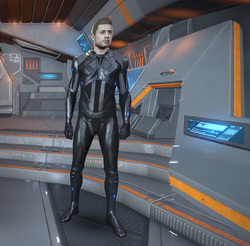
Human Male
Humans are a sentient species of bipedal mammals, native to planet Earth in the Sol system. Since the discovery of faster-than-light hyperspace travel, humans have rapidly expanded beyond Sol. They primarily populate a region of the galaxy known as the Core Systems, where they have colonized thousands of worlds and constructed tens of thousands of orbital stations, and in the 34th century, the advent of the Frame Shift Drive has enabled colonization efforts in several remote clusters across the galaxy. While a plurality of modern humans belong to a vast array of independent factions that constantly jockey for influence and power, the majority belong to one of the three superpowers: the Federation, the Empire, and the Alliance.
Biology
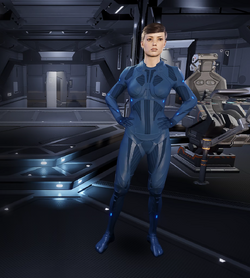
Human Female
Humans have a robust physiology. They are bipedal mammals and generally strong, fast and agile. They reach physical maturity at around 25 years old with the brain completing development. Then they enter the workforce or continue their education for a profession. The maximum human lifespan is naturally about 120 years, but advanced biotechnology and cybernetics have substantially increased longevity. Progenitor Cells are used to restore damage in older human cells and greatly extend human life expectancy.
Since the late 20th century there has been increased mixing of different human ethnicities. This resulted in improved genetic pools and certain recessive physical traits becoming rare such as blue and green eyes as well as blonde and red hair.
Early History
Evolution
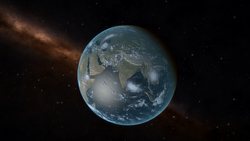
The human species (Homo sapiens) evolved from apelike ancestor over the course of 6 million years BCE (Before Common Era). Scientific evidence shows that humans and the great apes have a common ancestor that existed 8 to 6 million years BCE. Earth's African continent is where much of human evolution occurred. Fossils dating from 6 to 2 million years BCE originate only in Africa.[1]
A defining human trait to walk on two legs (bipedalism) evolved 4 million years BCE. Other human characteristics like a complex brain, using tools and capacity for language developed much later. Advanced human traits such as art, cultural diversity and symbolic expression developed during the last 100,000 years BCE.[1]
Agriculture
During much of human history, people lived hunter-gatherer lifestyles. The invention of agriculture in 12,000 BCE allowed people to live in permanent settlements which became cities and civilizations. As agriculture secured people's primary needs for food, this allowed attention to be focused on other things, like science, trade, technology, art, and innovation. Food production gradually expanded and fueled steady population growth, allowing Earth's population to swell from 5 million in 8,000 BCE to a peak of 8 billion by the start of early space colonization in the 21st century CE.[2] The devastation of World War III between 2044 and 2055 reduced the human population by over one billion and rendered much of Earth unsuitable for agriculture for a time, but humanity's spread to other worlds, plus the development of advanced automation, hydroponics, and terraforming, permitted the total human population to exceed 6.6 trillion by the 34th century.
Commerce
The demand of individuals and businesses to trade easily led to innovations in commerce and finance. In 9,000 BCE people bartered goods they had in surplus for things they lacked, such as cattle, sheep, vegetables and grain. The first known currency was created by King Alyattes in the ancient kingdom of Lydia, modern-day Turkey, in 600 BCE. The first coin ever minted featured a roaring lion design. Bank notes were developed in around 1661 AD. An advantage of paper money was that it could be mass-produced without relying on rare or expensive raw materials like gold and silver; in spite of this, its value is more unstable than precious metals. The first credit card was introduced in 1946. The first decentralized digital currency, Bitcoin, was invented in 2009 and wireless payments gained popularity. The invention of money and commerce has been essential to developing trade networks, fostering cooperation and understanding between different cultures and peoples across Earth.[3] Entrepreneurship and innovation lead to the Industrial Revolution, starting in Western Europe in 1760 AD, and the Digital Revolution in 1970 AD with inventions like digital electronics. Commerce brought people and countries together through mutual cooperation, division of labour and trade.
Colonialism and Imperialism
In the 16th century to the mid-20th century several European maritime powers used their technological and military advantages to establish colonies and claim vast territories in Asia, Africa, and the Americas. European culture and technology spread throughout the less developed world. During the 19th century and early 20th century most of Earth's landmass was controlled by European powers.[4][5]
World War I (28 July 1914 to 11 November 1918) was the first global war, and originated in Europe. World War II was the second global war (1939 to 1945) and had two opposing military alliances, known as the Allied and the Axis powers, comprising the majority of Earth's countries. World wars were different from previous wars, because they were fought between powers that had many colonies overseas. This meant that when two colonial powers went to war, their overseas territories went to war as well. The different ideologies and regimes from classical liberalism to national socialism, fascism and communism clashed in very destructive conflicts which killed tens of millions of people in both world wars. The remaining colonies gained independence in the mid-to-late-20th century, after World War II came to an end.[6][7]
Modern History

Elite Dangerous art
- Main article: Elite Dangerous Timeline
Consolidation
By the 2030s, major resource problems forced humanity to look to the stars for a way to relieve population pressures on Earth. Commercial organisations planned missions to build the first colonies on the Moon and Mars, as well as explore the rest of Sol for possible safe havens as political tensions on Earth rose to a boil.[8] The outbreak of World War III from 2044 to 2055 ground these efforts to an immediate halt. The conflict saw multiple nuclear exchanges occur between various countries. The United States of America was able to avoid suffering any nuclear detonations on its soil thanks to its defensive laser grid, which combined ground turrets with armed satellites to disable inbound enemy missiles before they reached their targets.[9] When the war finally ended, over one billion people and many countries had perished, and the United States was the only major country left mostly unscathed.[8] It quickly expanded into the United States of the Americas, a multi-continental hyperpower that dominated Earth, and eventually, as the last countries joined it, changed its name to "the Federation".[10]
Interstellar colonization
The 22nd century saw the dramatic rise of corporate power as corporations stepped in to rebuild human civilisation. This was followed by the discovery of the first extraterrestrial fossils on Mars, the launching of thousands of Generation Ships over several decades, and an explosive wave of exploration triggered by the invention of the first hyperdrive by Li Qin Jao's team of engineers. Hyperdrives were originally applied to unmanned interstellar probes, but were soon installed on manned spacecraft which overtook most of the Generation Ships. Despite the huge dangers involved, a massive interstellar land-grab followed, fueled by the voracious corporations.[11][12][13][14]
The year 2242 saw the ratification of the Federal Accord, a major turning point in human governance and interstellar colonization.[15] The Federal Accord was adopted by Sol, Tau Ceti, Delta Pavonis, Altair, and Beta Hydri, humanity's first five extrasolar colonies, and the Federation transformed from a global government into the first interstellar superpower, the "Federation of Star Systems". The advent of the Federation instilled some order within human space, which until that point had been an unruly free-for-all.[11]
Competition among superpowers
The Federation's supremacy did not last for long. In 2292, Earth-born anti-Federation activist Marlin Duval led her supporters to the distant Achenar system, where she founded the independent Republic of Achenar. Marlin's dream of an egalitarian nation free of the stifling control of Federal corporations did not last for long, however, as her death in 2296 resulted in her brother, Henson Duval, seizing power and transforming the Republic of Achenar into the strict hierarchy of the Empire, with Henson himself assuming the title of emperor. The Federation attempted to assert control over the fledgling Empire in 2324 under the pretext of punishing the Imperials for destroying the native ecology of Capitol, but the Battle of Achenar surprisingly resulted in the Federation's defeat and the Empire becoming a second superpower. This set off a decades-long cold war and centuries-long rivalry between the two.
Human colonization continued apace over the following centuries, with the Federation and the Empire constantly feuding over control of one colony or another, most notably the Alioth system. A third superpower, the Galactic Cooperative, emerged in 2696 from the Old Worlds, but its design as an isolationist trade union that prohibited member systems from interacting with any non-members spared it from becoming involved in Federal-Imperial squabbles. The Federation and the Empire were incensed by losing access to hundreds of potential member systems as the upstart GalCop grew and prospered, but neither desired a military confrontation.
In 2700, space travel was changed forever with the release of the original Python by GalCop corporation Whatt and Pritney Constructions, the first starship design that could be afforded by private individuals rather than corporations. The Python's modular construction also made modifying it for specific roles considerably easier, enabling owners to use it for combat and exploration as well as trading. The Python inspired a new era of innovative ship design that precipitated the rise of the first independent pilots.
The galactic balance of power shifted dramatically in the 32nd and 33rd centuries. GalCop rapidly collapsed and then dissolved in 3174, not long after fighting a 25-year war with an intelligent alien species called the Thargoids that devastated its economy. While it appeared that the political dynamic would return to the bipolar Federation versus the Empire struggle, the void left by GalCop did not remain unfilled for long. In 3228, a revolt in Alioth resulted in both Federal and Imperial forces withdrawing from the system, and in 3230, the Alliance was formally established as a new third superpower that sought to protect and support systems that desired to remain independent of the other two superpowers. The Alliance quickly spread to many of GalCop's old territories, including the Old Worlds, but rejected GalCop's isolationism and became an active player in interstellar affairs that the Federation and the Empire could not ignore.
The 34th century
Humanity's potential in the 34th century has only grown. The release of the Frame Shift Drive, the latest form of hyperdrive that has reduced travel times in hyperspace to mere seconds, has enabled rapid exploration and expansion on a scale not seen in centuries. New colony clusters were established in the Pleiades Nebula, California Nebula, Colonia Region, and Witch Head Nebula, endeavors which would have been considered overly costly and impractical only a decade before. However, this new wave of expansion has brought with it the reminder that humanity is not alone in the galaxy. As human activity in the Pleiades increased in response to the discovery of the lucrative resource known as Meta-Alloys, encounters with alien vessels were reported that were eventually confirmed to be Thargoids. The Second Thargoid War has been waged intermittently since 3303, and humanity has found itself in the defensive against a technologically superior foe. At the same time, the discovery of the ruins of the ancient Guardian civilization have provided a plethora of scientific insights and technologies that have improved humanity's odds in the conflict significantly. Furthermore, after centuries of division, the onset of the Second Thargoid War has resulted in humanity setting aside past differences to a degree and the three superpowers taking a unified stance against the common threat, a development represented by the creation of the multinational anti-Thargoid initiative Aegis.
Human territory
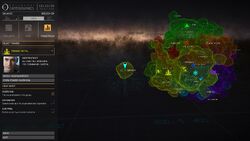
The bubble is where powers compete for influence, resources, territory and control.
Humans primarily reside in a region known as the Core Systems in the Inner Orion Spur, which contains about 19,000 star systems in an approximately spherical zone centered on Sol. Since the beginning of the 34th century, humans have also colonized several remote clusters of systems, including the Pleiades Nebula, the California Nebula, the Colonia Region, and the Witch Head Nebula.
Society
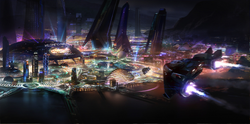
Human Megalopolis City Concept Art
As has been recorded throughout history, humanity is not prone to agreement over ethical, political, religious, and economic views. It remains this way today in the 34th century, with the human-colonized space held by numerous groups with various ideals and conflicts of interest.
There are three major factions, known as galactic superpowers, and several lesser Powers in human-colonized space. The Federation is based in Sol and is a representative-electing democracy. The Empire is based from the system of Achenar and is a hereditary monarchy. The Alliance is based from the system of Alioth and is a confederation of independent systems working cooperatively. Powers are influential individuals or organizations who strive to control human-inhabited space for their own agendas in Powerplay. Each Power can control a vast number of systems that are aligned to both major and minor factions. In addition to the three galactic superpowers and the powers, there are also many minor factions. The faction with the highest influence within the system will usually be the controlling faction of that system. System control falls on the faction that owns the controlling station. The government of a system is ruled by a controlling faction, and if that faction is classed as Anarchy, then no formal laws will apply in the system.
Videos
Gallery
References
- ↑ 1.0 1.1 Smithsonian: Introduction to Human Evolution
- ↑ National Geographic: The Development of Agriculture
- ↑ The Telegraph: The history of money: from barter to bitcoin
- ↑ Wikipedia: Colonialism
- ↑ Wikipedia: Imperialism
- ↑ Wikipedia: World War I
- ↑ Wikipedia: World War II
- ↑ 8.0 8.1 Elite Encounters RPG
- ↑ GalNet: Unexploded Nuclear Missile Discovered
- ↑ Tourist Spot 0165, "Ancient History"
- ↑ 11.0 11.1 GalNet: The Founding of the Federation
- ↑ Tourist Spot 0166, "Early Hyperspace"
- ↑ Tourist Spot 0168, "Early Colonies"
- ↑ GalNet: Galactic News: Hyperspace
- ↑ Tourist Spot 0174, "Federal Accord"



